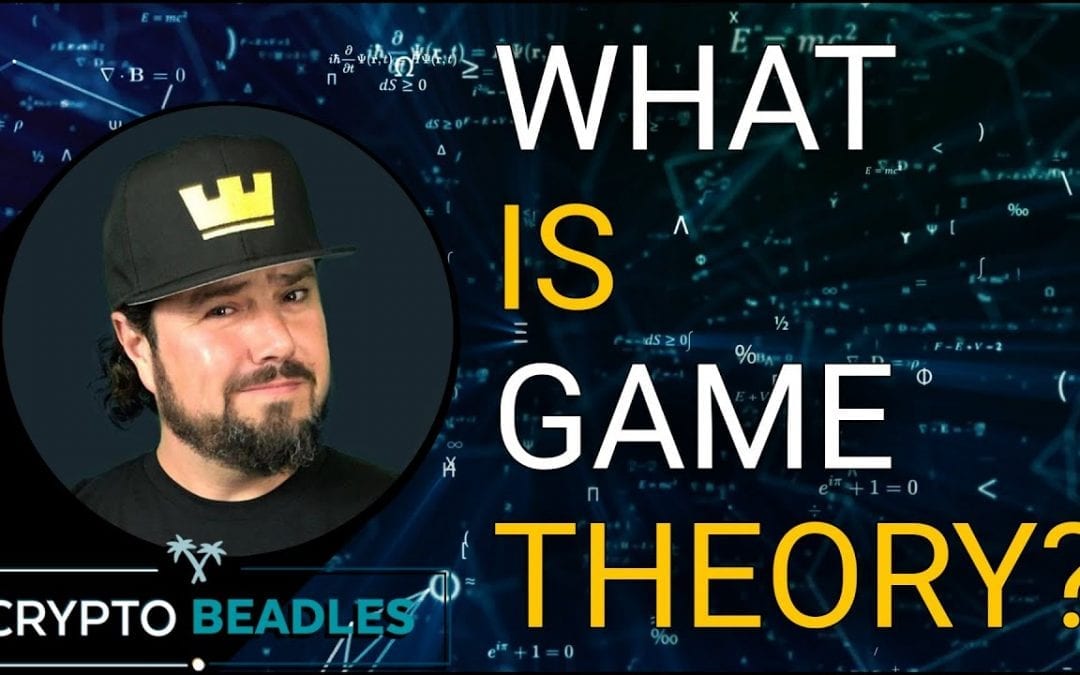


One Thousand Dollars in LIVE Giveaways! AMA and More!⎮Blockchain⎮Bitcoin⎮Crypto⎮
Join us Monday 1PM PST where we give away over One Thousand Dollars! We’ll talk crypto, blockchain, Bitcoin, Monarch and (more…)

What Gives a Dollar Bill Its Value?⎮Money⎮Banks⎮Value⎮Gold⎮
I answer your question, what gives a dollar bill it’s value! Join me here to discuss how value works in (more…)

What Is Blockchain? How are Blockchain & Cryptocurrencies Linked? What Are The Different Types & Uses Of Blockchains and Cryptocurrencies?

What Is Blockchain? How are Blockchain & Cryptocurrencies Linked? What Are The Different Types & Uses Of Blockchains and Cryptocurrencies?
Not all cryptocurrencies—and not all blockchains that the various cryptocurrencies rely on—are created equal. All cryptocurrencies rely on one form of blockchain technology or another to function—without blockchain technologies, cryptocurrencies would have no reliable way of handling the kind of decentralized, “trustless” accounting necessary to ensure a hack- and tamper-proof ledger of transactions.
It can be quite challenging to attempt to summarize all of the various blockchain technologies currently in existence—there are currently thousands of them. An easier way to go about doing this is first to look at the kind of blockchains currently in existence in a general sense, and then move on to a discussion of the various types of cryptocurrencies themselves.

Different Types Of Blockchains
Before discussing the different types of blockchains, it would be useful first to have an understanding of blockchain technology in general. Blockchain technology, defined at perhaps its most simple, is a distributed accounting ledger that is used to record transactions in a tamper-resistant, verifiable, and permanent manner. When blockchain technology is described as “open,” it refers to the open-source code that most blockchain protocols are built on.
Blockchain technologies can be either public (like Bitcoin) or private and still use this open-source code. Sometimes, you’ll see the term “distributed ledger” used to describe certain types of blockchains. This is really just another way of saying “decentralized,” as the continually developing ledger which records transactions are shared by multiple participants in the blockchain and is not owned or controlled by a single central authority.
Blockchain technology allows efficient accounting of any transaction between two parties, largely because there is no need to rely on a third party (like a bank, in traditional financial transactions) to verify or facilitate the transaction. A transaction is mutually agreed upon by the parties involved—an exchange of a set amount of cryptocurrency between crypto wallets, for instance—and is then entered into the ongoing ledger—the next block on the chain.
Once entered and verified by the blockchain network, the transaction is permanent and can’t be altered in any way. The various cryptographic schemes (like proof of work or proof of stake) behind these blockchains allow for both the accurate recording and verification of the transactions, resulting in a hack-proof system.
It can perhaps get a bit confusing with the new applications that blockchain technology is being used for. There are, in effect, three primary kinds of blockchains, if you’re not counting databases or distributed ledger technology, which are both built on the same technological foundations.

Public Blockchains
There are public blockchains—such as the kind used by Bitcoin, Ethereum, and in fact every other form of cryptocurrency. This type of blockchain is generally open-source and “democratic,” allowing anyone to participate simply as users making transactions through the blockchain, or as “miners.” Miners (called Validators in Ethereum) verify the validity of new blocks by solving complex mathematical “puzzles” through a proof of work protocol and are awarded a unit of cryptocurrency for their efforts.
Members of the public are also allowed to participate as community members and even to an extent as developers, suggesting or in some cases implementing advances and refinements in the way the blockchain functions. A good example of this is the Ethereum blockchain: though still using proof of work protocols for validation of new blocks, there has been substantial discussion of moving to a proof of stake system, which brings with it significant energy savings as it relies on one node for the validation of new blocks instead of many nodes all engaged in redundant work, in a race to “solve” the next new block.
Most significantly, all transactions recorded on a typical public blockchain are fully transparent and allow anyone to examine the details of any (and all) transactions. Refinements in blockchain technology allow for public blockchains with “private” functionality, which is blockchains that operate in much the same way as the Bitcoin public blockchain, but which are still capable of securely processing transactions, as we’ll see below in the discussion of so-called “private coins.”
Public blockchains are built to be completely decentralized, meaning there is no central authority, individual, or other entity controlling which transactions are entered into the ongoing ledger that makes up the blockchain or dictating the order in which they are validated and processed. Public blockchains are meant to be resilient, tamper-proof, and “censorship-resistant.”
This is accomplished by allowing anyone to join the network and run a full blockchain node, regardless of their geographical location, nationality, or other signifying characteristic. Because of this, it is next to impossible for governments or other would-be regulating authorities to interfere in the operation of a public blockchain.
Private (and Consortium) Blockchains
There are private blockchains—examples would be things like R3 Corda and Hyperledger. Also, sometimes called “permissioned” blockchains, private blockchains are different in a number of significant ways from public blockchains. In order to join the network of devices that runs a private blockchain, a would-be participant must first be granted consent.
Transactions are, therefore, more private, and are only available to those who have already been given permission to join the network. Private blockchains, while often not fully centralized, are much more centralized in nature than public blockchains, as they rely on something like a central authority to grant permission and oversee transactions. The authoritative bodies running a private blockchain have significant control over both participants and development (or “governance”) structures.
Private blockchains are most commonly used by enterprises who want to share data and collaborate by utilizing or accessing it, but naturally don’t want their proprietary business information available to any member of the public, which would be the case with a public blockchain.
Consortium Blockchains
Also sometimes called “confederated” blockchains, these are an offshoot of private blockchain technology, and are essentially the same as private blockchains with the marked difference that they rely on a group of authorities rather than a single entity. This allows different entities—in theory, different corporations, for instance—to collaborate using data available to every member of the consortium. Though they may be in direct or indirect competition, by sharing data that is common to their interests, they are able to collaborate effectively, and there is mutual benefit from such an arrangement. Consortium blockchains, it is hypothesized, will likely see use by entities like governments, banks, financial institutions, and corporations in the procurement, logistics, and supply chain sectors.

Types of Cryptocurrencies
Also sometimes called “confederated” blockchains, these are an offshoot of private blockchain technology, and are essentially the same as private blockchains with the marked difference that they rely on a group of authorities rather than a single entity. This allows different entities—in theory, different corporations, for instance—to collaborate using data available to every member of the consortium. Though they may be in direct or indirect competition, by sharing data that is common to their interests, they are able to collaborate effectively, and there is mutual benefit from such an arrangement. Consortium blockchains, it is hypothesized, will likely see use by entities like governments, banks, financial institutions, and corporations in the procurement, logistics, and supply chain sectors.

Payment Currencies
Cryptocurrencies of this type are intended for the payment of goods and services. Payment currencies can be used for transactions between private parties for whatever purpose, or (as is increasingly the case with Bitcoin) can be used to pay for tangible items in “the real world.” More businesses are accepting Bitcoin as a payment every day, and in some cases, local governments have moved toward accepting the cryptocurrency as a form of payment for things like parking tickets. In almost every case, payment currency cryptocurrency can also be “cashed out” from their digital form in exchange for local fiat currencies like the dollar, the euro, etc. Examples of well-known payment currencies are Bitcoin (BTC), Bitcoin Cash (BCH), Ethereum (ETH), Tether (TUSD) and Litecoin (LTC), among others.

Blockchain Economies
This is often argued as a step forward in the concept of digital, decentralized currency. A blockchain economy, which is often also called simply a blockchain platform, utilizes blockchain technology in broader, more innovative ways. Instead of merely existing to keep a record of various cryptocurrency transactions, blockchain economies allow their users to create things like discrete digital assets (most commonly referred to as tokens) and decentralized applications (DAPPS) that use the underlying blockchain technology as a basis for transactions of a different type.
In one notable instance, a cryptocurrency called Golem (GNT), while distinct and separate from the cryptocurrency primarily supported by the Ethereum blockchain (commonly also called Ethereum, but more correctly called Ether), exists entirely on the Ethereum blockchain. The value of Golem is not tied to that of Ether—it merely “piggybacks” on the Ethereum technology, which is designed in such a way as to make the creation of “tokens” like the Golem cryptocurrency possible.
Though this is an example of a cryptocurrency within a blockchain economy, the economies themselves are also used for the support and payment of things like virtual assets, processing power, the running of dependent applications, and many more various (and imaginative) purposes.
Perhaps the most notable cryptocurrencies falling under the example of blockchain economies would be Ether (ETH), Ethereum Classic (ETC), BCH (SLP), EOS (EOS), NEO (NEO), and Tron (TRX).

Privacy Coins
This is often argued as a step forward in the concept of digital, decentralized currency. A blockchain economy, which is often also called simply a blockchain platform, utilizes blockchain technology in broader, more innovative ways. Instead of merely existing to keep a record of various cryptocurrency transactions, blockchain economies allow their users to create things like discrete digital assets (most commonly referred to as tokens) and decentralized applications (DAPPS) that use the underlying blockchain technology as a basis for transactions of a different type.
In one notable instance, a cryptocurrency called Golem (GNT), while distinct and separate from the cryptocurrency primarily supported by the Ethereum blockchain (commonly also called Ethereum, but more correctly called Ether), exists entirely on the Ethereum blockchain. The value of Golem is not tied to that of Ether—it merely “piggybacks” on the Ethereum technology, which is designed in such a way as to make the creation of “tokens” like the Golem cryptocurrency possible.
Though this is an example of a cryptocurrency within a blockchain economy, the economies themselves are also used for the support and payment of things like virtual assets, processing power, the running of dependent applications, and many more various (and imaginative) purposes.
Perhaps the most notable cryptocurrencies falling under the example of blockchain economies would be Ether (ETH), Ethereum Classic (ETC), BCH (SLP), EOS (EOS), NEO (NEO), and Tron (TRX).
Utility Tokens
On a blockchain that supports it, the creation of a “token” is similar to, but not the same as, the creation of a unit of cryptocurrency. For a token to qualify as a utility token, there is, however, a strict set of legal regulations and requirements. We won’t go into those requirements here, but one example of a token that is currently considered a utility tokens is Binance’s “BNB” token. This token was initially created to allow for owners of the token to pay for trading fees with a discounted rate on the Binance Exchange.
Utility tokens can sometimes be digital tokens used in transactions to pay for or fund blockchain-based services or products. They typically run on a blockchain platform—which you’ll remember is another name for a blockchain economy. The most popular utility tokens to date are based on the Ethereum blockchain, but as new blockchains come into existence all the time, other blockchains have (and will continue to) spawn their own tokens.
Aside from BNB, other notable examples of utility tokens include the Basic Attention Token (BAT), Civic (CVC), OmiseGo (OMG), Monarch Token (MT), and 0x (ZRX).
Stablecoins
Lastly, there are stablecoins, so-called because (unlike other cryptocurrencies), they are intended to hold a fixed value and be traded at the same price, without market fluctuations being a factor. This kind of cryptocurrency is popular among investors and other traders of different kinds of cryptocurrency, as they represent a way to possibly hedge against possible losses in the secondary cryptocurrency being used to pay for the stablecoin.
For instance, say an investor holds $1,000 worth of Bitcoin. If that investor suspects that the value of the Bitcoin is likely to decrease in the near future, he or she could buy $1,000 worth of a stable coin asset, thereby divesting the held Bitcoin and being protected from the (assumed) devaluation. This, in theory, should protect the trader from financial loss—if his or her instincts are correct. However, with all things that have to do with money, there’s no such thing as a guaranteed thing. Everything has risks, and one must do their due diligence and contact professional financial advisors before making any decisions. Please note, this article is not financial advice, but to help give you a better understanding of the blockchain and cryptocurrency landscape.
The methods that different stablecoins use to maintain a fixed price vary. Stablecoins can be tied to a currency—for instance, a hypothetical stablecoin could be said to always be worth $1 USD. Though the value of that $1 USD may fluctuate, the stablecoin will always be exchangeable (at least in theory) for $1 USD. Like other commodities traded on traditional stock markets, stablecoins can also be tied to real-world commodities like precious metals, or in some cases, “baskets” of commodities, as is commonly done in traditional market investing.
Notable examples of stablecoins would include Dai (DAI), Gemini (GUSD), Paxos (PAX), Tether (USDT), TrueUSD (TUSD), and USD Coin (USDC).

Conclusion:
** This is not financial advice and these are simply my own opinions, as such, this should not be treated as explicit financial, trading or otherwise investment advice. This is not explicit advice to buy these cryptos, do you own research.**
***Disclaimer: Statements on this site do not represent the views or policies of anyone other than myself. The information on this site is provided for discussion purposes only, and are not investing recommendations. Under no circumstances does this information represent a recommendation to buy or sell securities.
***ALWAYS check with professional tax service providers and legal professionals before you buy, sell or trade cryptos!
Thanks for reading, God Bless and have an awesome one!
Be sure to check out our other articles on to cryptocurrency, bitcoin and blockchain technology below:
“Blockchain: What It Is and How It Works”; which delves into the history of blockchain, how blockchain works, how cryptocurrency uses blockchain, discusses anonymity, various types of blockchains and the different uses.
“What is Ethereum? How does Ethereum work? ETH Explored:” Dive deep into one of the largest blockchains, discover how it is different from Bitcoin and other cryptocurrency projects.
“How To Store Cryptocurrency / Safeguard Your Crypto Assets”; which discusses the most popular cryptocurrencies, how to protect your crypto, online wallets, offline storage, specialty hardware, crypto exchanges, and even gives Crypto Beadles Personally Recommendation with storing cryptocurrencies.
“Scrubbing Currency: A Comparison of Crypto to Fiat for Known Money Launderings”; This article dives into the various efforts to curb money laundering, typical money laundering with fiat currency problems faced by authorities worldwide, the rise of cryptocurrency, the differences between traditional fiat and cryptocurrencies, the history of traditional banking and it’s many failures.

LIVE $1,000 In BCH giveaways, Crypto, Bitcoin, Blockchain AMA and MORE!
Monday 1PM PST we announce the winners from YOUTUBE, TWITTER, Telegram and more! We’ll also hang out, talk Bitcoin, (more…)

What is Ethereum? How does Ethereum work? ETH Explored:

What is Ethereum? How does Ethereum work? ETH Explored:
Chances are you’ve heard of Bitcoin, the first cryptocurrency created in 2009 by a mysterious (some would even say shadowy) developer—or group of developers—using the pseudonym Satoshi Nakamoto. You may even be a little familiar with the blockchain, the virtual ledger of transactions that makes Bitcoin possible, and know that blockchain technology is expected to have a revolutionary impact on … well, everything. However, have you heard about Ethereum?
You may have heard of Ethereum and know that it’s a cryptocurrency similar to Bitcoin. It’s actually the second-largest cryptocurrency based on market capitalization, which (at the time of this writing) is over $18 billion USD; But Ethereum isn’t just a cryptocurrency—it’s a separate blockchain platform, with distinct differences to the one that underpins Bitcoin. The name Ethereum refers to the Ethereum blockchain—the proper name of the cryptocurrency is Ether (though it is often referred to as Ethereum or ETH).

Ethereum was launched on July 30th, 2015, by a group of eight developers. It was initially proposed in late 2013 by a Russian-Canadian programmer named Vitalik Buterin, who was joined on the project by Mihai Alisie, Amir Chetrit, Charles Hoskinson, and Anthony di Iorio. The initial five developers were joined by Joseph Lubin, Jeffrey Wilke, and Gavin Wood in early 2014.
At the time of its initial launch, a single Ether token (or “coin”) was worth about $0.30 USD. At the time of this writing, a single Ether token is worth $170.77. In other words, $30 of Ether in 2015 would be worth a lot more today than it was at its inception.

How Does Ethereum Work?
The Ethereum blockchain is an open-source platform used to create and run decentralized digital applications—commonly called “dapps”—that enable its users to conduct transactions directly with one another to buy, sell, or trade goods and services without a centralized authority serving as a “middle man.” Users of the Ethereum blockchain can transfer money without needing to first go through a bank, can draw up binding sales contracts without calling on the services of a lawyer, and can even raise funds for projects like app development through a system that relies on “crowd sales,” which operate in a way that’s similar to traditional crowdfunding systems, but (like everything on the Ethereum blockchain) is decentralized.
Ethereum runs on a global network of computers that work together as a sort of supercomputer, assembling and running “smart contracts,” or applications that operate independently of any third party. This means these smart contract apps are highly resistant to tampering—hacking, interference, or even censorship—as the Ethereum blockchain is (due to its distributed nature) theoretically impossible to hack.
While the blockchain that powers Bitcoin transactions was created almost solely for that purpose, the Ethereum project has always had larger goals in mind. In fact, Ethereum’s own website puts it in plain language, stating “Ethereum is a global, open-source platform for decentralized applications. On Ethereum, you can write code that controls digital value, runs exactly as programmed, and is accessible anywhere in the world.”
That code—the smart contracts—runs on what’s called the “Ethereum Virtual Machine,” which is another name for that decentralized, distributed computing network made up of all the devices running Ethereum nodes. Anyone can set up and run an Ethereum node, which provides computing power to the larger virtual machine. Anyone else can then run a smart contract—essentially, an application written to run on the Ethereum Virtual Machine.

Blockchain Differences: Ethereum vs. Bitcoin
The Bitcoin blockchain exists, first and foremost, to keep track of Bitcoin. Though other uses have presented themselves, that first blockchain was devoted to making ownership and transfer of the world’s first cryptocurrency possible. The Ethereum blockchain also tracks its own cryptocurrency—Ether (ETH)—but its main focus is far different. While the Bitcoin blockchain is (more or less) a ledger of transactions, Ethereum’s blockchain was built with a focus on running the decentralized applications written specifically for it.
The Three Layers of Ethereum
In order to focus primarily on running decentralized, distributed applications, Ethereum was constructed with three layers. The first layer is basically the blockchain—the large network of computers that process transactions and keeps a ledger of them, much in the same way that the Bitcoin blockchain works. The second layer is the software layer—the programming language (called Solidity) that the smart contracts are written in and run on. The second layer relies on the first for its operation. The third layer is made up of all the different applications that run on Solidity, with different features and offering different services to users of the Ethereum network.

Proof of Work
Then there’s Proof of Work vs. Proof of Stake. This gets a little technical, so bear with us. Proof of work is essentially a method of protecting against tampering or interference, like a distributed denial-of-service (or DDoS) attack. DDoS attacks work by tying up all of the resources of a targeted computing system by sending an avalanche of bogus requests—imagine someone tying up your phone by calling so quickly and so often that it was impossible to receive other calls or make any outbound calls yourself.
Proof of work—which was the central revolutionary idea behind the Bitcoin blockchain—allows for what are called trustless and distributed consensus systems. Basically, that translates into a system that relies on a public ledger of every Bitcoin transaction—ever—to keep track of the flow of the cryptocurrency. That ledger relies on “blocks” of transactions—and those blocks are “chained” together, each one relying on the one before it for proof of validity.
But these blocks have to be verified by nodes on the network before they’re accepted onto the chain. Think of it this way: each new block is like a puzzle with a set number of pieces. Those pieces are sent out—digitally—to every node on the blockchain network that’s set up to accept them. The only purpose of these nodes is to verify these new blocks. Now imagine each puzzle piece has a random number on it. The puzzles pieces will only fit together correctly one way—say to form a square—but the numbers have nothing to do with how the pieces fit together. That’s where the puzzle-solving comes in.
So, these puzzle-solving nodes scramble to assemble the puzzle correctly, trying to combine the pieces in different ways until they find the right order that makes the desired shape. The first one to get the square announces it to the rest of the network—essentially shouting “Bingo!”—and then transmits the instructions for how to put the puzzle together. The instructions are the order in which those random numbers must be assembled, row by row, to make the square. It takes some time to solve the puzzle, but once it’s solved, it can easily be verified by other nodes on the network (by following the pattern of random numbers, allowing them to form squares with their own puzzle pieces, thereby validating the work of that first lucky puzzle solver).
That’s the proof of work: the list of random numbers in the correct order to solve the puzzle. The way proof of work guards against tampering or DDoS attacks is pretty straightforward: an attacker can’t target every puzzle solving node at once, so even if they manage to shut down one or two, there are a bunch of other nodes working on the puzzle—which will still get solved.
That’s a very simplified example, but it’s more or less accurate. In Bitcoin, the puzzle solvers are called “miners,” and they’re rewarded for solving the puzzle by being allowed to create a new Bitcoin, which is their payoff for the amount of work they put in—work that was done to verify the new block on the blockchain, and solving these puzzles isn’t trivial. In some estimates, all the computers running the Bitcoin blockchain at any given moment are consuming about the same amount of energy as the entire country of Ireland. That’s significant.
Proof of Stake
Then there’s Proof of stake. This system operates much differently. Proof of stake works sort of like a lottery. You “buy-in” for the chance to validate a new block before it gets added to the chain—to check it over, run computations on it, and make sure it’s accurate. In fact, these block creators are called “validators” in the proof of stake system.
The validator is chosen more or less at random—like in a lottery—but the amount of cryptocurrency they’ve put up—their “stake” in the process—does have a direct effect on their likelihood of being chosen. Think of it like buying lottery tickets: the more you buy, the higher your chance of winning, though there is still the chance that someone who has bought fewer tickets (put up less stake) will get the prize. You don’t lose the stake you put up—in fact, if you’ve chosen to validate the new block, you receive a new unit of cryptocurrency as a reward.
The way this system guards against malicious action is simple—if you’re caught trying to alter a new block or do something shady with it, you do lose the stake you put in. It’s like a guarantee—in a proof of stake system, you’re essentially saying “I promise this much cryptocurrency that I won’t do dishonest things if chosen to validate the next block.” See the logic? The more you put up, the higher your chances of being chosen as a validator—and the greater your loss if the rest of the network calls shenanigans on you.
The single most significant advantage that proof of stake has over proof of work is that it’s much more economical. Once a validator is selected, they have the exclusive right to validate the next block in the chain. That means one computer doing computations—instead of hundreds of thousands all racing with copies of the same puzzle, trying to be the one to solve it first. The other validators aren’t wasting energy, which dramatically reduces energy consumption compared to proof of work, and this is (of course) much better for the environment.
Ethereum hasn’t yet converted to a proof of stake validation system, but it’s something that’s been widely discussed, and the current consensus is that (sooner or later), the Ethereum blockchain will run on proof of stake.
Other Benefits of Ethereum
Ethereum is, as we’ve seen, significantly different in terms of operation than the traditional Bitcoin blockchain. There are other improvements over the older technology—transactions are faster on Ethereum, at about 15 per second, while Bitcoin has less than half of the transmission speed, at about seven per second.
It’s also cheaper to send transactions on Ethereum than on Bitcoin. This gets complex very fast, but when you’re sending cryptocurrency, there’s always a transaction fee—the amount you’re paying to have that transaction transmitted through all of the various computers that make up the network. That fee has been growing on Bitcoin—transaction fees range significantly depending on how fast you want your transaction to go through.
However, Ethereum uses a different method of calculating transaction fees, and though it is comparing apples to oranges, it is still much, much lower. In Ethereum, you don’t pay per transaction—which is how Bitcoin does it—but rather per computational step, which is more befitting a network built and intended on which to run applications. Ethereum uses a system they refer to as “gas,” and each computational step requires a specific amount of gas. The price of gas is determined dynamically by the users of the network—higher network usage drives the price up, for instance—and the total fee is calculated as the amount of gas required times the current gas price. It may seem a little confusing, but it’s cheaper—current transaction fees on the Ethereum network are about $0.16.

Ethereum’s Amazing Flexibility
Perhaps the most fantastic thing about Ethereum’s blockchain system is how flexible it is. You can, for instance, easily create your own cryptocurrency. The Solidity program language and the Ethereum system has built-in, everything you need to write code that would allow you to create a new form of cryptocurrency, set a value to it, and allow for interested parties to buy and sell it. This is done by creating a “token,” or an object that has a certain value assigned to it by the creator. The value of the new cryptocurrency can change over time, and you could theoretically create a competitor to the Ether cryptocurrency while using the network that Ether is native to.
Not only that, but you can create games on the Ethereum network. The smart contracts allow for the creation of games of chance—like dice, or roulette—and there are, in fact, already Ethereum “casinos” which are increasing in popularity all the time.
To learn more about cryptocurrency, blockchain, and ethereum, please be sure to check out our blog post Here on the Top 25 Bitcoin, Blockchain and Cryptocurrency books!
If you enjoyed this article or learned something new, please share on a social media channel, tag a friend or send to a family member who might be interested in learning more about these technologies.

